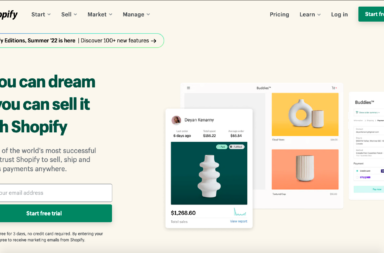If you are reading this, you probably already know that social selling is the latest wave in the tech-driven consumer revolution and you should be part of it.
Nowadays, customers are looking for trustworthy relationships with brands they can relate to and connect with. For businesses, this means meeting customers where they are: on social media.
However, if you want to succeed, you have to have a strategy.
We have compiled a list of 19 best tips & best practices for your successful social selling strategy, read on!
1. Show Up
Showing up might sound obvious but in order to be successful in social selling, you have to interact personally with your audience. Because you know what is not sexy? Robots. Nobody wants to buy stuff from a sales robot. People like to buy from people with whom they can truly discuss the matter and trust their expertise.
At the end of the day, social media are all about being social, right? That means if you want to succeed in social media selling, you have to show up and communicate.
Yes, you can obviously automate a lot on social media. Automated liking and commenting tools can save you some time but they cannot substitute human interactions and they definitely cannot build relationships.
Needless to say, you should be careful using such bots as they might damage your brand.
2. Be Authentic
Nothing beats a real, live human interaction. Social selling is all about participation.
Use your personality to drive the interest of your audience to your brand, your products, or services. If you want to be successful with your social selling, you have to put yourself into it.
Be present. Be your authentic self. Be personal and believable. Focus on your strengths and milk them. By removing the corporate mask, you are more likely to connect with people.
You have to (at least appear to) be genuinely interested in the product you’re selling, the business you’re selling into, and the people you’re talking to in that industry.
The goal is to make yourself seem more human and approachable—not less.
3. Build Your Credibility (Before You Start Selling)
Ultimately, your goal is to establish credibility and develop relationships that eventually lead to a sale. Social selling should never feel like cold outreach; your prospects should already feel that they can trust you.
Your company might have a solid reputation, but do you? Social networks can help you build your personal brand. You can grow your reputation and establish a solid foundation with every post or tweet on your social media.
Focus on your LinkedIn as that is the most obvious social network for engaging in social selling, particularly for the B2B sector.
Did you know that 90% of decision-makers never answer a cold call, but 75% of B2B buyers use social media to make purchasing decisions? You have to make sure you are active on LinkedIn.
When on LinkedIn, ask your colleagues, partners, and friends (with whom you have a good relationship) for endorsements and recommendations. Make sure your profile highlights expertise relevant to a potential customer, not only to a potential new employer. Don’t forget to highlight how you’ve helped previous customers achieve their goals.
Also, word of mouth can go a long way to helping you achieve this.
4. Keep Your Profiles Updated
This tip is connected to the previous point above: In order to build your credibility, you have to update your social media profiles regularly so they reflect your current activities and provide valuable information.
You want your profile to be a place that any company or potential customer can visit and find out all of the relevant information they’d want to create or continue a relationship with you. Make sure you are easily accessible, too.
It’s also important to ensure your profile picture looks professional and makes a good impression on potential prospects. Before you upload your image, ask yourself if you look like someone you’d want to do business with. Last but not least, make sure your profile picture is aligned with your company values.
5. Discover Connections & Extend Your Network
Once your social media profiles are updated and credible, it is time to expand! For instance, LinkedIn offers multiple ways to identify potential connections—people who might benefit from your product or service.
One of the greatest things about LinkedIn is its search functionality that is just perfect for social prospecting. Search for skills, job titles, companies, or industries that correlate with your buyer personas, and look out for people with whom you have shared connections. That way, you can use your existing relationship to send a connection request and start a conversation.
You can also expand your network by joining LinkedIn Groups that are relevant to your industry and business to start networking. This gives you an opportunity to get involved in conversations and demonstrate your expertise.
LinkedIn’s Sales Navigator is also a valuable social selling tool, as well as Nimble or Exigo.
6. Choose Your Channel Mix
Social selling can happen on any platform but it tends to be Twitter and LinkedIn. Part of the reason is that these platforms are more public-facing and people tend to use them for professional interactions.
However, the real winners of social selling are salespeople that are active on the same platform as their potential customers. This is the cornerstone of social selling success. This is why salespeople in fashion excel on Pinterest and why B2B sales reps generate leads from LinkedIn.
YouTube might be a great bonus to LinkedIn and Twitter as it is a perfect place to share video tutorials or explain complex ideas.
No matter what is your channel mix, focus on building a community.
7. Listen to Your Audience
And serve before you sell. Serving before selling means giving away valuable information for free. It means solving problems and offering solutions without a price tag attached. Always think about how you can help your audience. And in order to find that out, you need to listen carefully.
Social selling is a long-term relationship-building strategy that involves a lot of information gathering and active listening.
Your customers and prospects are sharing incredibly valuable information on their social channels—they’re basically telling you exactly what they want and need. All you have to do is pay attention.
In LinkedIn Groups or even in Facebook Groups, listen for the right moment to join the conversation so you can present yourself as a solution to a problem. The goal is to address a need to make your prospect’s life easier rather than becoming just another online source of annoyance.
8. Provide Valuable Information and Insights
If you’ve already listened to your prospects enough to understand their problem, try to provide valuable insight into it.
Try to humanize your pitch. Your goal should be to contribute with insightful information that can help establish you as an expert in your field. Write posts that share important knowledge, but don’t be afraid to share relevant posts from other credible sources as well. And yes, it could also be your competitors.
It’s obviously fine to mention your product or service in some of your posts on social media, but make sure your profiles are not walking sales presentations or pitches. At the end of the day, your goal in social selling is to establish relationships that will eventually lead to a sale, not to make a sale on first contact.
9. Give More than You Receive
Or more precisely: be ready to give more than you receive. You might be sharing valuable content daily, yet, it might not lead to sales straight away and that’s OK. Social selling is a marathon, not a sprint.
Keep being consistent with your content and make sure the majority of your social media posts are value-driven, with useful information that is meant to help your audience.
Moreover, spend a good proportion of time sharing other people’s content and leaving helpful comments. If you want to be successful, you have to give far more than you receive.
10. Create Content Regularly
As we mentioned before, you need to be ready to give more than you receive to be successful. Being helpful and providing valuable information is the key. And content is your king.
Every social selling expert needs a good content schedule that they follow to ensure the right information is being posted on a consistent basis, with proper timing and branding. This way, prospects can get to know you and with time, feel comfortable with what is being promoted or sold.
If you provide thoughtful comments and share valuable content, your outreach is likely to be reciprocated and that’s how you drive engagement.
11. Do Your Research
Don’t ignore the importance of researching your audience. The more you know, the better you’ll be at crafting effective social selling strategies in the future.
Luckily, you will find out that many prospects are keen on sharing their wants, needs, goals, and challenges on their social media. For you as a salesperson, it is an opportunity to get to know them a bit in advance and personalize your interactions with them.
To help you identify which people can become prospective customers, look for those who are searching for products or services that are similar to what you’re trying to sell.
If you come across someone who has bought from a competitor but didn’t have a positive experience, that’s a great opportunity to come in and sweep them off their feet with your brilliant solution.
12. Create Solid Relationships (Not Sales)
Sales has always been about building relationships, establishing rapport and credibility, and providing the right solution to the right prospect at the right time. Social selling doesn’t change that.
It’s the modern way to develop meaningful relationships with potential customers so you’re the first person or brand a prospect thinks of when they’re ready to buy.
If a contact moves to a new position or company, send a quick note of congratulations. If you notice a contact asking for help or advice, jump in with a meaningful answer, even if it doesn’t directly promote your product.
Focus on how you can help your contacts or make their lives easier. If you can establish yourself as their go-to person in your industry, guess who they’ll call when they’re ready to make a purchase?
13. Engage with Your Followers
Every relationship needs time and care. For social selling to be effective, you must interact with followers and connections regularly (and genuinely).
Stay in touch with your new social contacts over time. Pay attention to the content they’re posting, and from time to time, like or comment on their posts to let them know you’ve read and appreciated what they have to say.
Don’t overdo it, though, and be sure that your engagements with clients are meaningful. Like those posts that you actually like.
14. Continue the Conversation on Other Channels
We have already talked about the importance of differentiating social media. However, don’t feel like you have to limit your communication only to LinkedIn or Twitter.
Different platforms have different feels. Some of your prospects might appreciate seeing you being more playful on Instagram or TikTok, even though that obviously depends on the industry you are in.
Take that opportunity to form a bond that encompasses a range of different thoughts and emotions and you’ll likely have greater success in meeting your objectives.
15. Don’t Forget About Your Existing Customers
You might be fiercely chasing those new leads and new sales and that’s OK. But don’t forget there are your existing customers on social media, too, that have probably helped you in the past with your sales and revenue. They deserve your attention, too.
They say it is six times more expensive to win a new customer than to keep the existing one. If they have bought from your company once, they will likely buy again, but it can’t just be assumed they will.
Make sure you notice your loyal customers—they deserve your loyalty as well.
A massive advantage of existing customers is that you can ask them more profound questions and get relevant feedback. Take time to nurture your relationships with your loyal customers.
16. Check Regularly What Works
Social media keeps evolving and changing all the time. You have no time to underestimate them. Make sure you are up to date with the latest trends and updates. Real experts use what works and think about results.
It is fine to learn your lesson and adjust or change your original strategy if it didn’t bring you the results you wanted.
17. Track & Evaluate Results
True social selling professionals know it is crucial to collect data and insights from current and past efforts in order to optimize the process and bring positive results.
Every expert marketer tests, tracks, and measures, so if you want to be among the elite, it should also be part of your social selling strategy. Learning from what you’ve already tried is a great way to save time and maximize ROI with social selling.
18. Keep Up with Your Competitors
This whole article was focusing on you and your efforts regarding a successful social selling strategy. However, this picture wouldn’t be complete without your competition.
Social selling isn’t just for connecting with prospects, it’s a great way to gather competitive intelligence.
Monitoring what your competitors are doing can provide inspiration for your own social selling strategy. For example, perhaps they’re sharing a particularly informative piece of content, or targeting a certain type of prospect. And perhaps you could be doing the same thing.
Overall, your competition is a fantastic source of inspiration and knowledge and you should learn how to leverage it for your benefit.
19. Be Patient
And above all, be patient. Analyzing prospects and building (and maintaining) relationships will take some time. There is no shortcut to success, no ‘quick-fix’ solutions.
Remember: Great things take time.
Take a deep breath and keep working!
Conclusion
Social selling truly works and there are plenty of statistics proving it.
These 19 social selling tips & techniques should help you to tackle the power of social selling, no matter in which industry you are working. It is all about building relationships and providing insightful information while being authentic and credible.
We all know, a sales representative’s time is precious. And while social selling is a valuable tactic, you probably don’t want to spend all day on LinkedIn chatting to potential customers.
Luckily, there are plenty of awesome social selling tools which can help you create, execute, and measure your social selling strategy.
One of these is Exigo—a comprehensive software that was designed to help you stay on track while measuring your results so you can consistently and successfully optimize your social media channels for sales.


